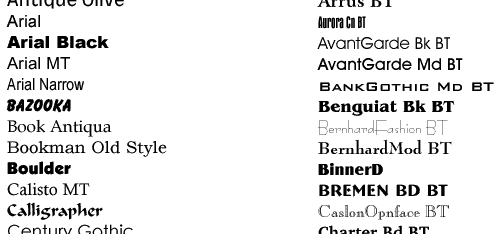The use of type not only revolutionized the scale of book production, but marked a significant conceptual change in the way writing was done. The original process of writing by the creation of letters became a process of writing by selection from a preformed set of letters. The human hand creates infinite variety. Different people have different handwriting, and even an individual’s handwriting will vary from one writing session to the next according to mood, fatigue level, posture, etc. Movable type changes all that. Individual Mycenaean or Carolingian scribes can be still identified by their work; not so the modern writer. Within a single font, the e in one word will look just like the e in the next, no matter who originally authored the individual words. How many people’s words, for example, have been uniformly recorded in Times New Roman type?
Inevitably, there were some who objected to the sterility of the new process. How could the spiritual value of a printed Bible possibly compare to that of one crafted by hand by a praying human soul? Equally inevitably, perhaps, the new technology won the day. The invention of movable type by no means halted to the activity of handwriting, but it did mean that most public texts thereafter were written by selection rather than by creation. At first the privileged domain of print shops, writing by selection has only become more dominant with the invention and widespread use first of typewriters and then of personal computers.
From The Writing Revolution, by Amalia Gnanadesikan
I came across this passage while researching for my thesis, and I haven’t been able to stop thinking about it: The idea here calls into question our very perception of creativity.

After all, we think of choosing among the different typefaces our computers offer as exercising our creativity, but it is really merely selection from the choices that the computer has to offer. Very few of us go to the lengths of designing our own typefaces, and I’m not sure anyone has done so for something like an essay.
For another example, let’s consider the place of handwriting in our society today. First, it’s not taught in schools anymore, possibly because of computers. My generation, for example, has horrible handwriting according to yesterday’s standards, probably because we type more than we write by hand.
How many other aspects of our lives has this touched? Certainly it goes beyond word processing. There are a million examples: Nowadays we’d rather choose between two flavors than create our own. We’d rather select from a list of topics for an essay than come up with our own. Art students invariably find it easier to work when they’re given some parameters rather than free reign over what they create. Teachers select from rather than create their own materials. Could the Enlightenment—the shift from alchemical to empirical science—also be a product of this movement? (And the worst part of it is, if we’re presented with too many choices, we find ourselves paralyzed. An excellent book on the subject is The Paradox of Choice by Barry Schwartz.)
I know I said “merely selection” above, as if selection were a bad thing. But is it? Certainly if we frame the question as choosing between coming up with our own ideas (creating) and stealing others’ ideas (selecting), then we’d probably say creating is nobler. But I don’t think it has to be. For instance, selection allows us as a society to focus our attention in different places. If we had to spend all our time designing typefaces or even just writing things our by hand, we wouldn’t be able to devote our thoughts to other things. (Though there are some who’d say that by speedily typing up our thoughts, we fail to think them through completely.)
And contrary to what Gnanadesikan says, writers must have selected to some degree before the printing press came along. Though the exact shape of the letter e might vary from one instance to the next, it had to be recognizable. If I were a medieval monk transcribing Bible pages, for example, and I decided to replace the letter e with a pictogram of a little zebra—and for good measure, sometimes I’d make it a lion or giraffe instead—I’d truly be creating. But people would have a harder time reading what I’d written.
Does that mean, then, that communication must be an act of selection in order to be successful? We do, after all, have to be familiar with the codes that our interlocutors are using or we won’t be able to decode their messages. We can’t invent words willy-nilly or transcribe our speech into senseless strings of characters if we want to be understood. The conclusion: Movable type and our modern propensity for selection, rather than creation, has aided the communication process. After all, in a communication system, consistency is a boon.
But what has this done to us outside communication? In art, for example? It’s an oft-asked question: Do artists or thinkers truly create, or do they select from things they’ve seen and heard? In other words: Are they creations, or permutations? If we really are only rehashing old ideas, is it possible that we actually created before the invention of the press? (It’s an intriguing idea; after all, around the same time that the press debuted, our artists returned their focus to Antiquity with the Renaissance.)
Is innovation truly possible? Did the invention of type change anything? Is selection inherently good or bad? Can we channel our creative roots by returning to handwriting?
 Follow
Follow

